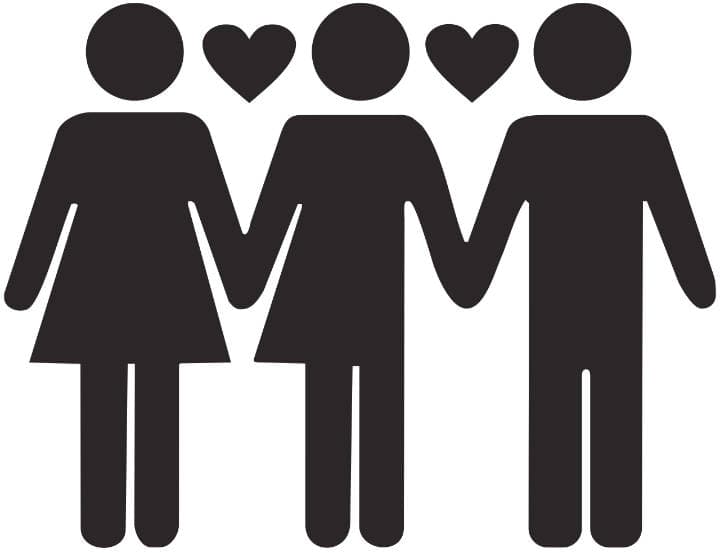Polyamory in a nutshell refers to a broad range of consensual, non-monogamous relationship types, as well as the belief that love may involve more than two partners at once.
In recent years, and especially with the rise of social media and other online dating platforms, non-monogamous lifestyles have become more common and accessible for many people.
Maybe you stumbled across the term in an online forum and now are interested in what it means.
Or perhaps a person in your social network told you they were “polyamorous” and now you are looking for answers to some of these questions:
- What is polyamory?
- Is polyamory cheating?
- What types of polyamory exist?
- Is there a difference between polyamory and polygamy?
- What to do if my partner is polyamorous?
What is polyamory?
Polyamory is the practice and lifestyle of involving more than two partners in ethical, consensual, and non-monogamous relationships with the knowledge of everyone involved. It is also the belief that love is not finite and may be extended to more than just one person at a time. The way how polyamory is practiced varies, ranging from closed triads or quads to two anchor partners having one or more relationships simultaneously and any variation thereof.
Polyamory is derived from the words “poly” – Greek for many and “amor” – Latin for love.
It includes a number of different relationship types which fall under the terms of “Ethical Non-Monogamy” (ENM), as well as “Consensual Non-Monogamy” (CNM).
Relationships of these types include multiple partners being involved with each other (however, not necessarily all with the same people) with the consent of all participants.
The polyamory community is often loosely associated with the queer, and LGBTQ+ communities, due to the fact that homo- or bisexual relationships are often part of polyamorous groups. However, they are not identical.
Polygamy vs Polyamory
Polyamory means loving multiple people or engaging in more than one romantic relationship, whereas polygamy is the plurality of marriage and having multiple spouses. In that sense, polyamory refers to the capability and lifestyle of engaging in multiple romantic relationships at the same time, while polygamy is concerned with a legal state of marriage. Polygamy is illegal in many countries around the world, while there are rarely laws governing polyamory.
People often confuse the two or speak about them synonymously, however, this is a common misconception.
Polygamy is a reference to one person having multiple spouses, whether or not there is love or consent involved is irrelevant.
When a man has multiple wives, the technical term is polygyny, while a woman marrying more than one husband is called polyandry.
Polyamory, on the other hand, is more concerned with interpersonal relationships which may be emotional, sexual, or of any other type between different partners.
The big differentiators to other types of relationships are consent and knowledge of everyone about all the ongoing relationships of their partners.
While polygamy is illegal in most countries (mostly to protect women from being forced into polygynous marriages), polyamory is legal and ethical.
Is Polyamory Cheating?
Polyamory as part of the range of ethical non-monogamous and consensual non-monogamous relationships is not cheating. Polyamory is based on the belief that love is non-exclusive and that consent and knowledge are the first steps to establishing such connections with others in a meaningful way.
As a matter of fact, polyamory is based on honesty and open communication above all.
All partners know about the romantical and emotional connections of each other, which differs from cheating which is done through secrecy and deception.
As such, polyamory is neither a way of nor an excuse for cheating nor rooted in it.
Despite the non-monogamous nature of polyamory, it is still possible that partners in such a connection cheat on each other.
The way this is perceived or done, however, might differ from monogamous, as well as monoamorous relationships.
Types of Polyamory
There are many different types of polyamory that people engage in.
As a core belief of polyamory is that love is not a limited or finite resource, and not limited to a certain amount of people, all these types can be found in different constellations and in multiple combinations.
Hierarchical Polyamory
Hierarchical polyamory is practiced when two partners see each other as the “main” or “primary” partner, and all others outside as “secondary”.
An example is a married couple who share a home, finances, and have children, and allow each other to explore romantic interests outside their marriage.
However, at all times the primary relationship stands above all others.
This is probably the most common form of polyamorous relationships, though in many cases it resembles more of an open relationship than other types listed below.
Anchor Partners
Some polyamorous people don’t like the concept of hierarchy in their relationships, and instead, refer to their “live-in” partner or spouse as an anchor partner.
This indicates to them that all their relationships are equally important and their partners equal, however, they do choose to share their life with an anchor partner over others.

As such, anchor partners are sometimes called “nesting” partners instead.
Triad / Throuple
Triads or throuples (“tri” = three) are formed by three people in a joint relationship. In most cases, all three partners are committed and in love with each other, however, there are also variations thereof.
Such relationships often start out as couples who are later joined by a third person completing their triad.

Triads can often be found in the queer community, as the nature of their relationship usually engages with bisexual relations and love.
Quad
Quads (from “quad” = four) are formed by four people in a committed relationship.
Most often, such connections are formed by one couple starting to date another, but any types of variations are possible (but much rarer).
In some cases, only cross-gender partners engage romantically, and physically with each other (meaning each woman with the other man), or any combination thereof.
Vee
In a “Vee” style relationship, one person dates two (or even more) people separately from each other.
While these two people are then referred to as “metamours”, meaning they are connected through their love for the same person, they are not romantically involved with each other.
Whether they know each other or never meet is up to the involved partners.
Of course, each of these metamours is free to pursue multiple further relationships of their own.
This type of relationship or connection is one of the most common ones in the polyamorous community, as it does not require the commitment of different people to each other.
Polyfidelity
Polyfidelity refers to a polyamorous relationship of three or more people who agree to be “closed“, meaning they do not engage sexually, or romantically with people outside of their dynamic.
Often times, this is found in throuples with at least two bisexual partners who agree to only be committed to each other.
You might also come across the term “polysaturation” in this regard, which refers to the state when no further partners can or should be added to a dynamic for various reasons.
Relationship Anarchy
Relationship anarchists believe in having the freedom to get involved with anyone they choose romantically and sexually without restrictions, hierarchy, or lables. They aim to live in autonomous relationships free of jealousy, which may range from romantic involvement to friendship or “friends with benefits”.

In relationship anarchy, all these relationship types exist but are equal in value and validity.
There might still be rules though, especially if there are anchor partners who are married or share a life together.
Solo Polyamory
Solo polyamory refers to people having multiple relationships independent of each other while living a single or open lifestyle.
There is no hierarchy and not all of these relationships may turn into romantic partnerships.
Solo polyamory is also used as a term to describe polyamorous people not currently in committed relationships or after breaking up with their previous partners.
Foundations of polyamorous relationships
Polyamory is based on a strong belief in love, trust, and communication. Ethical and consensual non-monogamy is based on the following core values:
Honesty
Being honest with yourself and your (potential) partners is important to live an ethical non-monogamous lifestyle.
This includes being honest about expectations, beliefs, desires, and involvement with other people.

Transparency
Along with honesty, transparency is important to ensure everyone is on the same page in regard to current romantic and sexual involvements of their partners.
While open relationships often follow a “don’t ask, don’t tell” mentality, polyamorous people believe that open, up-front communication is key.
As such, if you live in a polyamorous relationship of any sort you can expect your partners to tell you about their other love interests without having to ask for it first.
Individuality
Polyamory means opening up your heart and mind to the possibility of being romantically and/or sexually involved with multiple people at the same time.
However, it’s important that you remember that you do NOT need to follow any rules, labels, or expectations except your own and those you agreed upon with your partners.
In polyamory, you do you.
Do what feels right and ethical to you and if your style of relationship does not fit into any of the above categories, that’s okay, too.
Are polyamorous relationships healthy?
Polyamorous relationships are as healthy, or unhealthy as their monogamous/monoamorous counterparts. Loving and engaging with multiple partners is not inherently unhealthy, and as a matter of fact, very common among humans throughout history.
The key is to follow ethical practices and being open about your desired way of life.
In actuality, polyamorous and other openly non-monogamous people are often happier than many monogamous couples, as they allow themselves to pursue sexual and love interests without shame, guilt, or secrecy.
This is NOT a way of saying that non-monogamous relationships are superior to monogamous ones.
Is polyamory for everyone?
No! Polyamory and other non-monogamous lifestyles are definitely not for everyone and that’s okay. Just like in other areas of life, people with similar beliefs and lifestyles tend to find each other while everyone else follows a different approach. Never pick up a polyamorous lifestyle as a favor to someone else and only pursue it, if you are 100% convinced of it yourself!
Never pick up a polyamorous lifestyle as a favor to someone else and only pursue it, if you are 100% convinced of it yourself!
What to do if your partner is polyamorous
When your partner or potential partner opens up to you about being polyamorous, it is important that you first fully understand what each other’s expectations and feelings are in regard to your relationship. Remember that being polyamorous is not (always) a choice and there are many different types of living polyamory in practice.
Communication is key when it comes to relationships, and this is especially true for non-monogamous ones involving multiple partners.
Find out what your and your partner’s feelings and expectations are, and how they know they are polyamorous.
Especially in established relationships, it can be a shock to one partner to hear about their partner wanting to live polyamorously.
Initial reactions often include disbelief, sadness, anger, or disappointment.
This is why I always recommend polyamorous people tell their potential love interests right away about their desired relationship style.
Of course, many people only learn about this part of their identity later in life.
If your partner discovers they are polyamorous, evaluate honestly and openly, if you can continue to be with them.
If you are in such a situation, remember that it is your right to be happy in your relationship at all times.

Don’t confuse sexual non-monogamy with polyamory either.
For some people, it can be enough to simply engage sexually with other people outside of their main relationship. Others actively desire or look for multiple romantic relationships, which is what polyamory is all about.
No matter what you do or decide:
Never give up yourself to fulfil the needs or desires of another person but yourself.
In some cases, two people may truly love each other, yet they are not able to continue their relationship due to differing views on commitment and boundaries.
If you are in this situation, that is okay!
Polyamory is not “for everyone” and it also cannot always simply “be learned“.
Do what makes you happy and then decide if you can live a fulfilling life with a polyamorous partner.
How to tell your partner you are polyamorous
Telling your partner or potential partner about being polyamorous is important to prevent disappointment, distrust, or worse at later stages of your relationship. Talk to them about your feelings openly and be honest about your desires and expectations. Give them a chance to explore their own feelings in this regard first, before making decisions about the future of your relationship.
I personally have been in the situation of telling and explaining to partners about being polyamorous on multiple occasions.
Each time was different, and so were the reactions.
From my experience, the sooner they know this about you, the better it is for everyone.
If they are not open to any kind of non-monogamous or polyamorous relationship, this will prevent both of you from greater disappointment later on.
Nothing is worse than falling in love with someone and being committed to each other only to separate much later because you cannot come to terms with your different views on your relationship.